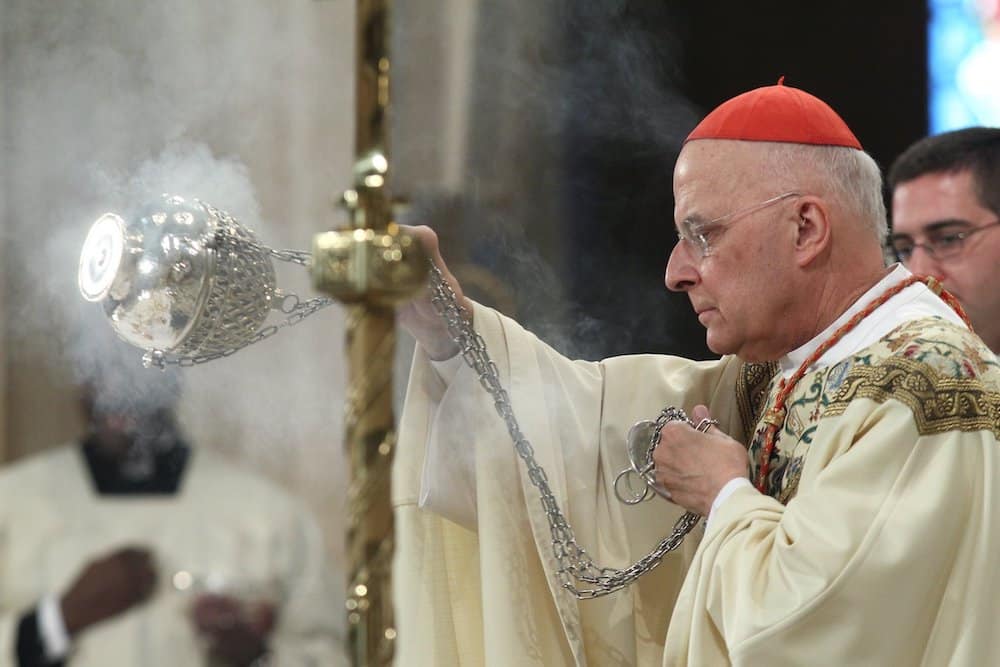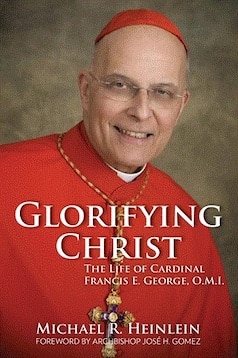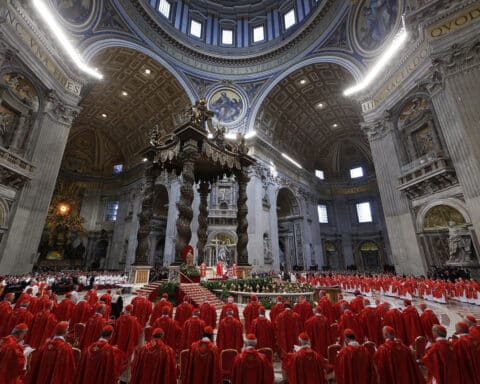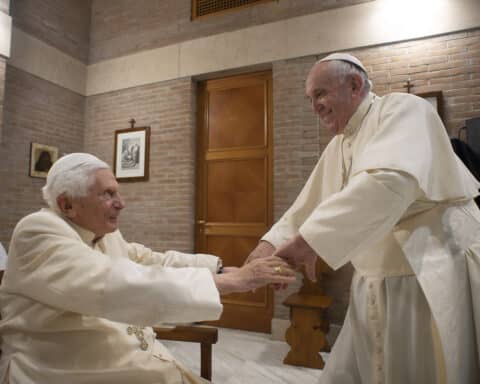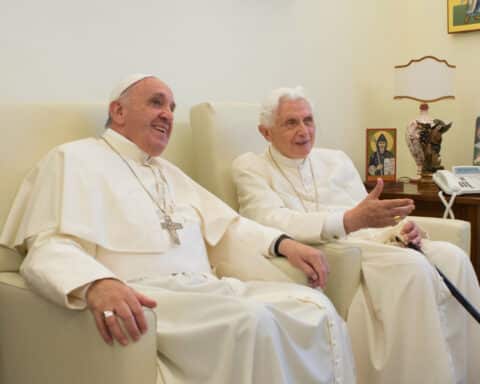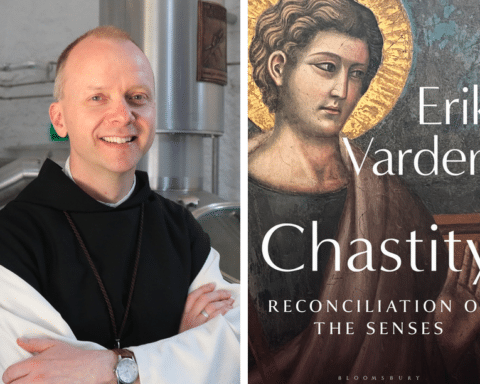“Cardinal George represented the best of Chicago; super smart, tough, direct, compassionate,” said the late Australian Cardinal George Pell. Those virtues — intelligence, resilience, sincerity and kindness — are an apt summary of the remarkable character of Cardinal Francis George, who served as the archbishop of Chicago (1997-2014) and died eight years ago on April 17, 2015.
A new biography by Michael Heinlein, “Glorifying Christ: The Life of Cardinal Francis E. George, O.M.I.” (OSV, $29.95), helps readers appreciate the quiet strength of Cardinal George. Showcasing Heinlein’s thorough research, the book offers a comprehensive telling of Cardinal George’s life, painting a full picture of this courageous champion of the Catholic faith. In an exchange with the author, I asked a few questions about the new book and about the author’s views of Cardinal George, his legacy, and what he would say about topics such as synodality being raised in the Church today.
Our Sunday Visitor: A full biography is not written about every cardinal; why is Cardinal George worth remembering today? In what ways was his life especially heroic and inspiring?
Michael Heinlein: I would be remiss if I didn’t begin by saying it was a privilege of a lifetime to get to study and write about this dedicated disciple of Jesus Christ: Cardinal Francis George, OMI. You’re correct — not all cardinals, holy and good men as they might be, become the subjects of written works. The ecclesiastical actions of cardinals — as bishops, or occasionally just priests — in governance, teaching and other spheres often deserve some kind of historical record. “Glorifying Christ” contains a good deal of that. But not all such figures have such inspiring and interesting life stories. I also hope readers of this biography will get to discover the extraordinary character and discipleship of Cardinal George that sets him apart from the majority of his peers. Through a rare depth of faith, he learned to see his lifelong disability that stemmed from a difficult bout of polio as a gift. With a unique perseverance, he overcame rejection from the priesthood on account of that disability. With a razor-sharp mind and a true devotion to fostering unity in the Church, he led in difficult times. I think that any believer who engages with Cardinal George’s story will find something to strengthen his or her own spiritual life.
| BUY THE BOOK |
|---|
|
To purchase Michael Heinlein’s new book, “Glorifying Christ: The Life of Cardinal Francis E. George, O.M.I.,” visit OSVCatholicBookstore.com. |
Our Sunday Visitor: What aspects of Cardinal George’s early life might inspire today’s parents? When and how did he discover his vocation to the priesthood?
Heinlein: Cardinal George was an ordinary Chicago boy. He rode his bicycle around the neighborhood, played softball on the streets and was outgoing and gregarious. In the 1940s in Chicago, the parish was the hub of every neighborhood. St. Pascal’s was the center of Cardinal George’s childhood. He was a student in the parochial school, a dedicated altar boy — encouraged by his parents to be involved and active in assisting the parish pastor. These experiences, and certainly the encouragement and example of his parents, strengthened and nurtured a call to the priesthood that he first heard on the day of his first holy Communion in 1945.
Our Sunday Visitor: How was his life and leadership influenced by the fact that he was a religious who ministered for many years in Rome?
Heinlein: There is no small sense of irony — or, better, providence — in the fact that Cardinal George ended up living in Rome for a dozen years as vicar general of his congregation, the Oblates of Mary Immaculate. I say this because he was told he could not be a priest in Chicago because of his disability that affected his right leg and hand and caused him pain every day of his life. Serving in that capacity, from 1974-86, he traveled the globe, visiting dozens of countries. He never slept in a hotel while visiting his brother conferes, always staying with the local missions, sometimes sleeping on floors. The global perspective he gained gave him a truly Catholic understanding of the Church. The experience also made him something of a rarity among the American episcopate and the college of cardinals. Also, during his years as Oblate vicar general, Pope John Paul II was elected. Observing the early years of John Paul’s pontificate up close made a profound impact on Cardinal George.
Our Sunday Visitor: What particular challenges did Cardinal George face as archbishop of Chicago?
Heinlein: Years before his appointment to Chicago, Cardinal George unwittingly asked Cardinal Joseph Bernardin what it was like to govern a place like Chicago. In response to this, his future predecessor laughed off the Windy City Church, calling it “ungovernable.” The political life of the city makes ecclesiastical life complicated. The clergy often kept their own counsel there, and the archbishop tended to be looked upon with suspicion. Some of the priests rejected Cardinal George upon his appointment to Chicago in 1997, writing to the apostolic nuncio and complaining about his desire to take interest in active governance. The clergy sexual abuse crisis also exploded during Geroge’s time in Chicago, but he worked hard for reform – including pushing for the “zero tolerance” rule that has become a building block of the American Church’s response. He also became a model for the pastoral care of abuse survivors. Overall, George found his position in Chicago meant it was hard to trust and be trusted. He sometimes felt like a failure. In addition to the disability that resulted from polio, Cardinal George also faced nine years of struggles with bladder cancer and its effects.
Our Sunday Visitor: What are the most important parts of the legacy he leaves behind in the archdiocese?
Heinlein: Cardinal George took a keen interest in developing more robust formation programs for those in ministry and more faithful adherence to liturgical norms. He enacted important reforms in the wake of the clergy abuse crisis. He was a man of pastoral availability to clergy and people. Despite his important position and many other duties, Cardinal George is not often discussed for his pastoral skills. Often the last to leave an event — and the first Chicago archbishop to visit all of the archdiocese’s parishes — George was an authentic and unpretentious shepherd who connected with his flock. As Cardinal George was repeatedly asked about his legacy at the time of his retirement in 2014, he chose to point to Christ and others rather than himself. Preaching in his last public homily as Chicago’s archbishop, he said: “At some point, Christ will question me: ‘What have you done with my people? Are they holier because of your ministry? Are they more generous? More loving toward others?’ In short, you are my legacy.” And he acted as if that was truly the case.
Our Sunday Visitor: How might Cardinal George have navigated the pressing questions of many in the Church today, particularly, those regarding human sexuality, the nature of the priesthood and synodality?
Heinlein: Cardinal George was scholarly and brilliant. He was a clear and nuanced thinker. He was uncompromising in his proclamation of the Church’s immemorial teaching, and he was a courageous defender of the Church’s faith. I don’t think any of the questions the Church wrestles with today were not somehow wrestled with during his time as a priest or bishop. He always navigated such situations by articulating the Church’s teaching, but always with charity, with the Church’s unity as his goal. He worked diligently, as a bishop especially, to implement the ecclesiology and reforms of the Second Vatican Council with fidelity and authenticity — seeing in the conciliar texts the source for unity in ecclesial life today.
Our Sunday Visitor: Was Cardinal George a liberal or a conservative?
Heinlein: When George was appointed eighth archbishop of Chicago in 1997, the media tried hard to pigeonhole him as liberal or conservative. And so did a certain number of his clergy as well. He replied to these questions, or flat-out characterizations, as imprecise and unhelpful. “The Faith isn’t liberal or conservative,” he said to the Chicago press who pushed him to pick his own label. “The Faith is true, and I will preach the Faith.” And he did just that.
Our Sunday Visitor: How would the cardinal hope to be remembered?
Heinlein: Cardinal George was a man who accomplished a great deal in the Church and for society. Many remember him for different things: as a scholar and professor, as a religious who helped his congregation weather complex times, as a respected leader elected president of his episcopal conference. Cardinal George’s fingerprints were on many of the important decisions and actions of the Church in this country during his episcopal tenure. In the end, though, it seems that Cardinal George hoped to be most remembered as a pastor, one who gave his all to the tasks of teaching, sanctifying and governing. Asked in 2014 how he would like his people to remember him 50 years on, Cardinal George said, “I would want them to remember that I tried very hard to love them.”
Father Patrick Briscoe, OP, is editor of Our Sunday Visitor. Follow him on Twitter @PatrickMaryOP.

